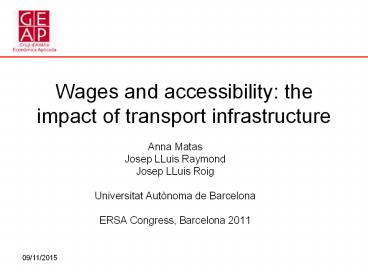Wages and accessibility: the impact of transport infrastructure - PowerPoint PPT Presentation
1 / 24
Title:
Wages and accessibility: the impact of transport infrastructure
Description:
Wages and accessibility: the impact of transport infrastructure Anna Matas Josep LLuis Raymond Josep LLuis Roig Universitat Aut noma de Barcelona – PowerPoint PPT presentation
Number of Views:73
Avg rating:3.0/5.0
Title: Wages and accessibility: the impact of transport infrastructure
1
Wages and accessibility the impact of transport
infrastructure
- Anna Matas
- Josep LLuis Raymond
- Josep LLuis Roig
- Universitat Autònoma de Barcelona
- ERSA Congress, Barcelona 2011
2
Contents
- Introduction
- Productivity and market accessibility
- Data
- Estimated models
- Results
- Conclusions
3
Introduction
- Objective to assess the impact that investment
in road infrastructure can have on firm
productivity. - Moreover, we also look at the impact of
agglomeration effects on productivity. - Productivity is approached by individual wages.
- Workplace is allocated at NUTS III level.
- Repeated cross-section data for 1995, 2002 and
2006. - Empirical evidence using micro-data Graham
(2007), Combes et al. (2008), Mion and
Naticchioni (2009), Gibbons et al (2010),and for
a review Melo et al (2009). - Empirical evidence for Spain (on firm location)
Alañón and Arauzo (2008), Albarrán, Carrasco and
Holl (2008), Arauzo (2005), Holl (2004, 2006),
Matas and Roig (2004)
4
2. Productivity and market accessibility
- Improved accessibility allows for larger
economies of scale due to wider potential markets - Improved accessibility increases exposition to
competition and generates incentives to higher
efficiency. (Sorting of higher productivity firms)
5
- - Improved accessibility can affect economies of
agglomeration in two ways - 1. Better accessibility can attract new and
relocating firms to positively affected areas,
increasing the size of agglomeration - 2. Better accessibility increases the spatial
scope of economies of agglomeration
6
3. Data
- Source Spanish Earnings Structure Survey (EES)
1995, 2002 and 2006. - Micro data on individual wages
- Spatial unit provinces (NUTS III)
- Data on workers and firm characteristics
- Sectors manufacturing services
7
Summary statistics
8
Summary statistics
9
Market potential 2006
10
Change () in travel time 1995-2006
11
Change () in market potential 1995-2006
12
CHANGE IN TIME () VS CHANGE IN POTENTIAL ()
13
Estimated equation
14
Estimated coefficients OLS
Robustness coefficients of interest are highly
stable to the selection of control variables
15
Possible endogeneity problems
- Troublesome explanatory variables market
potential, employment density, specialization and
human capital - Instruments market potential in 1980,
population density in 1860, specialization in
1980 and demographic structure in 1991 (share of
19-15 years minus share of 9-5 years)
16
Estimated coefficients IV
17
Test for instruments validity
18
Hausman exogeneity test
- Ho variables are exogenous
- All sectors
- Robust score chi2(5) 500.269 (p0.0000)
- Robust regression F(5,310309) 101.226 (p
0.0000) - Manufacturing
- Robust score chi2(5) 136.947 (p0.0000)
- Robust regression F(5,164840) 27.7033 (p
0.0000) - Services
- Robust score chi2(5) 287.792 (p 0.0000)
- Robust regression F(5,145431) 58.1808 (p
0.0000)
19
Results
- Positive and significant effect of road
accessibility on wages with a similar impact on
manufacturing and services industries. - Non linear effect of employment density with a
different pattern for manufacturing and services. - Evidence of positive human capital externalities
- Positive specialization effect more significant
for manufacturing than for services. - Distance to French border is significant for
manufacturing but only marginally for services.
20
Elasticity of wages (productivity)
21
Effects of employment density on wages
22
Elasticity wages-employment density
23
Conclusions
- Accessibility measured through market potential
positively affects wages (Productivity) - Evidence of agglomeration economies measured by
employment density - Evidence of human capital externalities After
controlling for individual educational level, the
human capital of the province is positive and
statistically significant
24
Pending task
- Infrastructure investment reduces travel time,
increases potential, increases productivity and
this leads to a further increase in market
potential - Take these feedback effects into account must be
the target of further research - Include measures of accessibility for other
transport modes































